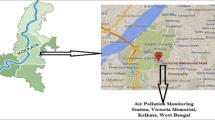Abstract
This paper deals with the problem of modelling air pollution time series recorded at a given point by using a multi-layer perceptron based approach. In particular it is shown that the traditional back propagation (BP) algorithm, widely considered in the literature for this kind of application, can be improved to predict episodes of poor air quality. A novel version of the BP algorithm is developed and its performance is compared with that of the traditional algorithm in a case study which refers to the modelling of 1 h average maximum daily ozone concentration recorded in the industrial area of Melilli (Siracusa, Italy). The results obtained so far indicate that the proposed algorithm outperforms the traditional BP algorithm.







Similar content being viewed by others
References
Chelani AB, Chalapati Rao CV, Phadke KM, Hasan MZ (2002) Prediction of sulphure dioxide concentration using artificial neural network. Environ Model Softw 17:161–168
Dorling SR, Foxall RJ, Mandic PD, Cawley GC (2003) Maximum likelihood cost functions for neural networks models of air quality data. Atmos Environ 37:3435–3443
Gardner MW, Dorling SR (1998) Artificial neural networks (the multilayer perceptron), a review of applications in the atmospheric sciences. Atmos Environ 32(14):2627–2636
Haykin S (1999) Neural networks—a comprehensive foundation. Prentice Hall, London
Kolhmainen M, Martikainen H, Ruuskanen J (2001) Neural networks and periodic components used in air quality forecasting. Atmos Environ 35:815–825
Melas D, Kioutsioukis I, Ziomas I (2000) Neural network model for predicting peak photochemical pollutant levels. J Air Waste Manage Assoc 50:495–501
Nunnari G, Nucifora A, Randieri C (1998) The application of neural techniques to the modelling of time-series of atmospheric pollution data. Ecol Model 111:187–205
Nunnari G, Dorling S, Schlink U, Cawley G, Foxall R, Chatterton T (2004) Modelling SO2 concentration at a point with statistical approaches. Environ Model Softw 19(10):887–905
Rumelhart DE, Hinton GE, McLelland L (1986) Parallel distributed processing exploration in the microstructure of cognition, vol 1. MIT, Cambridge, pp 45–76
Schlink U, Dorling S, Pelikan E, Nunnari G, Cawley G, Junninen H, Greig A, Foxall R, Eben K, Chatterton T, Vondrácek J, Richter M, Dostal M, Bertucco L, Kolehmainen M, Doyle M (2003) A rigorous inter-comparison of ground-level ozone predictions. Atmos Environ 37:3237–3253
Volta M, Nucifora A, Nunnari G (1998) Real time ozone episode forecast: a comparison between neural network and grey box models. In: Proceedings of the international ICSC/IFAC symposium on NEURAL COMPUTATION-NC’98, ICSC Academic, pp 854–860
Author information
Authors and Affiliations
Corresponding author
Rights and permissions
About this article
Cite this article
Nunnari, G. An improved back propagation algorithm topredict episodes of poor air quality. Soft Comput 10, 132–139 (2006). https://doi.org/10.1007/s00500-004-0435-y
Published:
Issue Date:
DOI: https://doi.org/10.1007/s00500-004-0435-y




